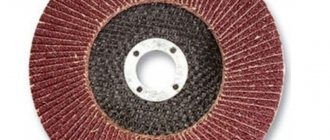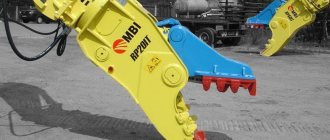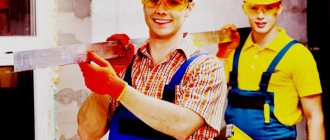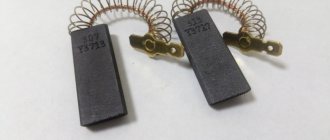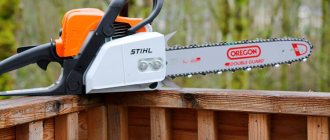Abrasive or carved discs are equipment for an angle grinder (aka “grinder”). Such equipment belongs to the category of consumables, with the help of which work processes are carried out. These disks have another name - circles (due to their similarity). They are based on a multilayer reinforcing base, but they are made not from steel, but from abrasive materials. The reason for this is the fact that when two steel elements come into contact (when one of them rotates), both of these elements will quickly overheat, which will reduce productivity. The abrasive base consists of small carbide or electrocorundum fragments, which have an increased density. When cutting metal through such circles, their smallest fragments simply burn out, thereby creating a cut.
Scope of use
The equipment in question can be classified by application into specific categories of materials - wood, metal or concrete. Each type of this device will have its own distinctive properties, but most often cutting wheels are used for cutting metal. Such metal objects of work may include the following products:
- From metals and their alloys;
- Of steel;
- Made of cast iron;
- Stainless steel;
- From non-ferrous metal (copper and aluminum);
- Made from galvanized products.
Fundamentally, an abrasive cutting disc differs from other attachments designed for processing wood or concrete. It's all about the consistency of the abrasive material, which for concrete and wood is applied to the disc much less.
Which diamond blades are better?
Our experts selected products from the world's best manufacturers, considering offers in all categories. High-quality universal discs exist, but they are more suitable for home craftsmen who have decided to make major renovations to their home or build an extension. Professionals should use a specialized tool, and each category has its own leader. We recommend the following brands of diamond blades:
- Makita B-28092 – for cutting concrete on a construction site;
- Graff GDD 17 125.10 – for low-cost brick work;
- Dremel DSM540 – for high-precision cutting on ceramic tiles;
- Di-Star 1A1R Decor Slim (11115427010) is a good choice for the decorator;
- Hammer 206-232 – for wet cutting of metals;
- DeWALT DT40252 – for intensive work with any metals;
- Bosch Standard for Universal 2608615059 is a durable and reliable universal.
Good equipment means high productivity, operational safety and high-quality cutting. Only the best wheels, distinguished by their thoughtful design, perfect edge quality and heat resistance, are worthy of this high title.
Cutting disc material
Due to the fact that an angle grinder or “grinder” is a universal piece of equipment, it can replace many other tools, for example, a hacksaw for wood or metal. The versatility of the equipment described is achieved through the use of a wide variety of attachments made from a variety of materials. Discs for cutting metal products are considered to be often used; a little less popular is for equipment for sawing wood - after all, the “grinder” is not fully suitable for this. An abrasive wheel for cutting metal consists of two bases - a reinforcing layer used as a working base, and a layer of silicon carbide or corundum particles deposited on it. The last particles are applied in the form of small or enlarged grains, which are attached by fusion to a reinforcing base, which can be vulcanite or bakelite.
Choosing between vulcanite and bakelite
The above materials are practically the same type and are standardly used for the production of cutting wheels for grinders. The reinforcing layer itself is visually represented as a mesh with small cells, which is located inside the nozzle. As distinctive positive and negative properties of these basic materials, the following facts can be mentioned:
- A vulcanite disk has increased elastic properties, which allows manufacturers to produce equipment with a small thickness (from 0.8 millimeters). They are based on rubber and sulfur that have undergone special processing. They add elasticity to the circle, which has a positive effect on work productivity, because thanks to the elasticity, there are no disturbing extraneous vibrations. At the same time, the compacted structure of the entire material prevents the risk of destruction and damage to the circle itself. Vulcanite wheels are perfect for thin and burn-free cutting. The disadvantage of such devices is their poor resistance to elevated temperatures, therefore, when the heating limit of 160-200 degrees Celsius is reached, their destruction occurs. This is where the rule comes from: the thicker and denser the product being cut, the faster the wheel will heat up and its useful performance will decrease.
- Bakelite bases can withstand temperatures ranging from 250 to 300 degrees Celsius, however, they spark strongly during operation. They are based on a consistency of formaldehyde resins in powder form with accompanying fillers. If it is necessary to cut dense/thick metal, for example, beams or rails, you need to use exactly these discs. In turn, bakelite has less elasticity, which leads to production vibrations.
- Circles made on the basis of a ceramic bond are the most expensive. This is due to the fact that they are based on many different materials - feldspar, quartz, refractory clay, talc and others. Their main difference is that they can easily interact with moisture and have fire-resistant properties. Among the disadvantages is poor resistance to mechanical loads. In principle, ceramic bond wheels are equally suitable for both thick and thin materials, and the main condition for use will be their careful use.
IMPORTANT! Reinforcing elements called binders may not be present on abrasive discs. This will naturally affect their strength and durability, but such models will have a lower price. However, in the absence of a reinforcing layer on the disk, it is better not to use such equipment on dense materials!
Differences between working fragments – carbide and electrocorundum
It is possible to find out which abrasive element is installed on a particular wheel by studying the corresponding markings. However, the functionality of these elements is limited to certain properties, therefore, their use on any material is not recommended. A cutting disc made with electrocorundum inclusions is perfect for cutting dense steel objects. This is due to the fact that electrocorundum fragments are softer, which has an excellent effect on productivity when processing strong types of steel. Silicon carbide wheels are characterized by increased hardness, so they are best used on non-ferrous metals, stainless steel, galvanized steel and other soft objects. Also, silicon carbide and electrocorundum wheels also differ in their resistance to elevated temperatures. For example, the latter are able to withstand temperatures as high as 1900 degrees Celsius, while for the former this figure is limited to 800 degrees. This limit can be even lower if boron carbide or diamonds are used as abrasive fragments.
How to choose the right products
To obtain a positive result, it is not always important how much a particular product costs. Besides price, there are many factors to consider during the purchasing process. Let's look at the main ones:
- Have information about the maximum number of revolutions. The more resourceful the grinder, the smaller the size of the discs you should purchase.
- Understand what diameter structures your angle grinder is ready to work with. Exceeding this limit will negatively impact performance and may result in equipment failure.
- Performance indicator. The market is filled with inexpensive Chinese goods, the quality of which has many complaints. You shouldn't mess with them. Fruitful work with such consumables will not work. You'll just waste your money, time and nerves.
- Socket size. It should be identical to the parameters of the grinding machine.
- Scope of application and list of tasks assigned to the tool. The material you have to deal with is of great importance. It is worth buying either special attachments for wood, metal, marble, stone or a universal type.
Outer and inner diameter of cutting wheels
Due to the fact that angle grinders differ in size and power, for each of the existing tool variations, discs of the appropriate sizes in internal/external diameters are used. Modern manufacturers produce circles with the following dimensions (in millimeters) for various types of grinders:
- 115 - used exclusively for low-power household equipment;
- 125 – suitable for both household and semi-professional models of “grinders”;
- 180 – aimed at the segment of medium and high power angle grinders;
- 230 – used on powerful equipment for direct professional use.
Circles can be larger than 300 millimeters, but they are used exclusively on special equipment and working machines.
Regarding the mounting holes, i.e. their internal diameters, then the “dispersion” in numbers is much smaller there - there are only three main types (in millimeters):
- 22;
- 22,23;
- 32.
The second type is the most popular, because it is suitable for “grinders” with double landing shaft sizes – 22.23 and 22 millimeters. The 32mm holes in the circles indicate their use only on special machines. There are also smaller internal diameters, such as 10, 13 and 16 millimeters. They are mostly intended for fine (“jewelry”) work, and the outer diameter of such disks does not exceed 100 millimeters.
Diamond blade rating
To compile the review, we tested the cutting tool and compared the results obtained on the main technical characteristics with the parameters stated in the manufacturer’s documentation. The availability of consumables on the market, the opinions of professional builders, installers, and car mechanics were taken into account. Reviews of diamond blades from owners of small home workshops were studied.
The following characteristics were taken into account:
- Size – determines the depth of cut, the possibility of using a grinder or a wall chaser of a certain model, productivity;
- The diameter of the mounting hole - no gaps and a tight fit on the shaft makes work safe and efficient;
- Rotation speed – must correspond to the same characteristics of the power tool;
- Class – professional and semi-professional models are produced;
- Design – equipment is produced with a solid and segmented cutting edge;
- Type of cutting – consumables are used for dry and wet cutting.
Not all equipment met the experts' requirements. Rapid clogging of the edge, low service life of the working layer, defects in the geometry of the plane - products with such defects were excluded from our rating.
The best gas cutters
Thickness of cutting wheels
Wheels with a large thickness are more often used for sharpening/grinding, and with a fine thickness (i.e. thin) - for making cuts/cuts. However, the minimum thickness of the disk will not be less than 0.8 millimeters, and the maximum will not exceed 4 millimeters. When choosing disks by thickness, you must be guided by the following categories:
- To achieve an effective result when cutting, you will have to put in less effort and spend less time if the equipment has a small thickness;
- In cases where a thick circle is used, doing quality work will require more time and more effort.
However, some experts still prefer discs with greater thickness, justifying their choice by the fact that they have increased strength and are less susceptible to destruction. However, practice shows the opposite: cutting metal with a thin disk is much safer, but before starting work it should be selected properly. Safety is justified by increased elasticity, with the possibility of their unhindered bending in the absence of irreparable deformation, which nozzles with large thickness cannot boast of.
The best diamond blades for concrete
The most popular category of cutting consumables. The diamond-coated blade easily copes with cutting any type of concrete. This circle is used for dismantling work, adjusting door and window openings, and laying communications in the walls of buildings. The equipment is supplied by professional wall chasers, cutters, grinders and furrowers. VyborExperta.ru recommends products from 3 brands, which are distinguished by reliability, workmanship and performance.
Makita B-28092
The equipment of a popular Japanese manufacturer is designed for dry cutting of concrete, brick, and artificial stone. It has a segmented structure that improves the quality of the cut. The diameter of 125 mm allows use in branded diamond saws and classic angle grinders. During intensive work it hardly heats up; short breaks of 2-3 seconds are enough for the tool to be ready for cutting concrete again.
The thickness of 2.1 mm and the absence of vibrations ensures accurate cutting of concrete of any strength grade. The 7 mm diamond layer height ensures long tool life without loss of performance. The 22.23 mm mounting hole has precise geometry and fits tightly on the power tool shaft, without gaps. The consumable is designed to work with high-performance tools at a speed of 12,250 rpm.
Advantages:
- Low price;
- The design of the segments allows for efficient removal of dust;
- Does not rotate on the shaft under load;
- Stable cutting quality throughout the service life;
- Designed for intensive use.
Flaws:
- Not detected.
Engineers from a Japanese company have developed a technology for uniformly distributing artificial diamond grains along the cutting edge. This has a positive effect on cutting speed and service life. We use our own diamonds with sharp edges.
Graff GDD 17 125.10
The diamond blade for the grinder, developed by Belarusian engineers, can be used to equip stone-cutting machines and hand-held concrete cutters. The equipment is manufactured using thermal crimping technology and has a long service life. It has a turbocharged edge with specially shaped channels that effectively remove dust from the working area. This increases the service life and ensures maximum cutting accuracy.
The model is universal, can be used for dry and wet cutting, used on natural and artificial stone, ceramic and paving slabs. The equipment is designed for high speed – 12,250 rpm. Features a smooth ride and professional performance. The material is resistant to high temperatures and dynamic impacts, which ensures personnel safety.
Advantages:
- Cutting edge height 10 mm;
- Does not crumble the edge of the processed material;
- Good balance;
- Low price;
- Professional spraying quality;
- Durability.
Flaws:
- The 2.5 mm thickness is not suitable for all applications.
Metabo Promotion 624307000
A segmented disk with a classic shape of outlets, which have a large contact area with air, effectively removes dust and helps cool the tool. Designed to work with concrete, hard sandstone, wet concrete and adobe. Installed on angle grinders, hand-held wall chasers or branded diamond saws. Recommended for power tools with a shaft rotation speed of 12200 rpm.
Used for dry cutting, 10 segments do a good job of dissipating heat. The cutting layer height is 7 mm, the edge uses a mixture of artificial diamonds and a binder pressed under high pressure, which ensures a long service life. The connection of the segments to the steel core is carried out by pressing at high temperatures.
Advantages:
- Small thickness;
- Uniform distribution of diamonds in the cutting plane;
- Rigid design for stable operation;
- Low price;
- High performance.
Flaws:
- Cannot be cooled with water.
Influence of hardness characteristics
The disc models under consideration have different hardness, which will depend on the material of manufacture. When selecting a nozzle according to this parameter, you should be guided by a simple rule - the harder the material you plan to process, the less hard the material used to make the equipment used should be. As a striking example, the following advice can be given: to cut/sawing cast iron, metal or steel, you should use electrocorundum equipment. But for cutting aluminum, copper or stainless/galvanized steel, you can get by with a silicon carbide nozzle. In addition, it should be remembered that the hardness of the disk will also be affected by the size of the grains - this parameter is indicated on the front side of the circle and is marked with the letters “M” and “T” (“soft” and “hard”, respectively).
IMPORTANT! It is also necessary to pay attention to the “hardness index”, which is indicated by two numbers after the corresponding letter. Thus, the higher the number, the higher the hardness.
Marking of cutting discs and its meaning
Any cutting equipment for angle grinders must have accompanying markings, which reflect all the most necessary technical data. Only knowledge and ability to decipher the meanings indicated there will help you choose the appropriate type of nozzle. Below is the basic information that is required:
- The manufacturer's name is indicated at the very top.
- The size of the internal diameter (seat ring), thickness and outer diameter are marked directly under the seat hole and can be as follows: “180 x 1 x 22”.
- The material of objects on which it is possible to apply a circle. Typically, the inscriptions are made in Latin, for example, Metal - for abrasive models, Steel - cutting steel, Aluminum - cutting aluminum and other non-ferrous metals, Inox - stainless steel, Castrion - cast iron and cast steel. There are also universal samples on which the functionality is designated “Uni”.
- Types of nozzles that indicate the design features of the mounting hole. A flat circle is designated by the numbers “41”, which has an offset to one side – “42” (this is how sharpening and grinding attachments are usually marked).
- Bond material – refers to vulcanite, bakelite or ceramic base. On Russian models it is designated by two letters, for example, “BU” - “reinforced bakelite”. The same marking in English looks like “BF” - “Bakelite forced”.
- Type of material for making the circle. The letter “A” means electrocorundum, the letter “C” means silicon carbide. Before the letter there should be numbers indicating the size of the fragment (grain).
- Hardness is reflected in the letters “M” and “T” and must be followed by the corresponding hardness index.
- Maximum operating speed - it depends on the type of reinforcing ligament. For bakelite this parameter is set in the range from 80 to 100 meters per second, for vulcanite this indicator varies from 50 to 80 meters per second. The overall speed of work will depend on the rotation speed.
- Shelf life is the most important parameter responsible for the overall usability of the disc. Nowadays, few people pay attention to this period, which, in turn, often leads not only to the breakdown of the tool itself, but also to injury to the operator. Therefore, this parameter must be checked before purchasing. It is indicated in the form of month and year and is located on the steel part of the seat ring. If this period has expired, or there is less than a month left before its expiration, then the use of such an attachment is strictly prohibited.
IMPORTANT! In addition to the basic information, other data may be indicated on the front of the disk, at the request of the manufacturer. These may include the names of GOST, in accordance with which the wheel was produced, its imbalance class, sound index and similar optional information.
What types of attachments are there for angle grinders?
The store shelves are impressive with the variety of products on offer. All manufactured accessories for grinders are divided into the following main types:
| Type | Description |
| Stripping and stripping | The type of working surface is two circles fastened together or in the shape of a bowl. The edge has the appearance of a wire or brush. Designed to free the surface from old layers of varnish, paint, and rust. Often used during repair work at service stations when putting cars in order. They can easily and simply remove plaster or concrete from the surface. |
| Cut-off | A distinctive feature is the small thickness of the nozzle. Limits – from 1 to 3.2 mm. Cutting type edge. |
| Polishing and grinding | Parquet scraping, roughing or final finishing cannot be done without them. There are quite a lot of varieties. Each attachment is produced to perform a specific type of work. |
| Sharpening | Classic looking circles. Available for use on grinding machines. The thickness is significant - up to 0.5 cm. Designed for sharpening tools and cleaning welding seams. Ideal for rough grinding of metal structures. |
| Milling | They are produced in two types: in the form of a circle and a cutter. The first is intended for woodworking, the second creates recesses and grooves, processes edges and ends. |
Based on the material you will have to deal with, nozzles are divided into the following categories:
- For working with stone. In the manufacture of the cutting element, silicon carbide abrasive is used. Available whole and segmented. The solid ones are designed to interact with limestone and dolomite, the second - with tiles and hard surfaces.
- Processing material: metal. Steel structures. The abrasive surface is electrocorundum or alumina.
- For working with wood. A large number of saw wheels are produced. Which one is better to buy depends on many factors. A distinctive feature is the shape of the teeth. Straight and variable beveled devices are available. Pine needles and other soft woods are cut first. The latter belong to the universal type. On sale you can find cloves shaped like a trapezoid. They are very popular when working with medium and high density materials.
Diamond wheels are distinguished separately. They are produced in steel and have inclusions in the form of diamond chips. According to buyers, they are distinguished by reliability and increased wear resistance. There are solid diamond blades and segmented diamond blades on sale.
Diamond bits differ in their fixation technology, and therefore they are divided into:
- laser welding and sintering;
- electroplating
Based on the type of artificial diamonds used, accessories are divided into the following groups:
- polycrystalline (designed for soft materials);
- monocrystalline (work with stone and durable metal).
Cutting wheels
The most common type of attachment for an angle grinder. They differ in purpose. Popular models are available for:
- Metal. The main manufacturing material is crystalline corundum or electrocorundum. Inside the product there is a bakelite bond. They differ in size and thickness. Can handle metal profiles, heating pipes, stainless steel.
- Concrete and stone. Silicon carbide is used in manufacturing. Purchased for cutting soft materials: slate and white brick.
- Tree. Several types of popular models are available: carbide made of tungsten carbide and metal with abrasive coating. The first option is used for cutting gas silicate, plasterboard, soft wood, and MDF. The second one will master the metal. Which company's product is better depends on personal preference. Many craftsmen purchase Zubr Professional 36859/125 products. It is inexpensive, but high quality and reliable.
- Concrete and ceramics. Ideal for cutting red brick, paving stones, ceramic tiles. Available in metal. The cutting edge is equipped with diamond chips. They are produced in solid all-metal and segmented versions. The first option involves wet cutting, the second - dry. Experts advise giving preference to the durable segmented wheel Makita B/28086. It will quickly and efficiently cut stone and concrete structures.
- Universal. They feature advanced functionality. However, it is recommended to purchase specialized attachments for cutting wood. A review of reviews shows that these are the best consumables if you have to deal with various surfaces during the working day. Able to cope even with reinforced concrete. The average price is high. Where can I buy them? At any specialized retail outlet or order online in an online store. Suitable for both dry and wet cutting.
What should you pay attention to so as not to get lost in the variety of products offered? To the appropriate marking. All manufacturers put special designations on structures indicating the purpose of the product. The letters indicate the type of metal you can deal with:
- inox – will handle stainless steel;
- steel – copes with steel;
- aluminum – the best option for non-ferrous metals and aluminum;
- castiron – suitable for casting and cast iron.
Diamond blades, in addition to markings, also have their own color:
- yellow ones are purchased for cutting tiles and plaster;
- gray ones will master ceramic tiles and tiles;
- green ones are for granite;
- blue ones can handle marble and concrete;
- orange ones are suitable for brick and plaster.
Manufacturers produce circles for cutting plastic. This can be a regular abrasive disc for metal or a special consumable in the form of a three-tooth saw wheel. It can handle not only plastic, but also plywood and wood. They can be used for both longitudinal and transverse cutting of materials.
Diameter of structure
Cutting discs are produced with different external diameters - from 115 to 500 mm. The most popular models are consumables with the following diameter:
- 18 – 23 cm – purchased as an attachment for a professional tool whose power exceeds 1500 kW;
- 12.5 – 15 cm – intended for equipping angle grinders of medium size and power;
- 11.5 cm – purchased for installation on small-sized angle grinders.
Everyone's selection criteria are different. But the diameter of the disk should be selected based on the class of the angle grinder.
The seat (inner) diameter for household level tools is standard and is 22.23 mm. For ease of selection, all sizes are indicated on the front of the circle.
Basic Safety Precautions
Setting the circle to the correct side
The front part of the disc depicts the logo of its manufacturer, technical markings, and also contains a metal washer. On the other side, which is free from any inscriptions, there is no such washer. As a rule, it is not written on the disks themselves which side is correct for installation, therefore, here banal logic comes to the rescue:
- If the cutting attachment is installed with the pattern and marking facing outward, then the person will always see what he is using. And this fact is important if the tool is used by several people at the same time.
- If the disk is installed with the pattern facing inward, i.e. “jacketed” to the equipment gearbox, and its metal washer faces the flange, it will be clearly visible that the abrasive surface will come into contact with the clamping nut. Thus, during operation, the nut may be overtightened and it will simply be impossible to unscrew it. And this can already lead to damage to the instrument.
IMPORTANT! The wrench, usually supplied with an angle grinder, should be designed to unscrew the clamping nut, which can also be tightened manually using a self-tightening process.
Cutting process: direction of sparks
Each specialist uses his own methods of handling the grinder. You can cut with sparks towards yourself or away from yourself. Both of these methods have pros and cons.
If you cut with sparks falling away from the operator, then:
- The view of the working area will not be blocked by anything (because the sheaf of sparks will not obscure it);
- Sparks flying in the opposite direction from the operator and the risk of accidentally burning clothing is almost non-existent.
As a “minus” we can mean that a “reverse strike” can occur, and if the operator is unable to hold the tool in his hands, then it will simply fly towards him, which can create a traumatic situation.
If you cut in your own direction, then:
- Falling sparks will cover the work area;
- Sparks will fall on clothing.
The advantage here is that even with a reverse impact, the operator’s safety will not be in danger - the tool will fly in the exact opposite direction.
Eliminating the risk of tool jamming
Particular safety must be observed when cutting thick workpieces (for example, profile pipes). In this case, it is necessary to properly position the workpiece so that at the end of the cut the edges of the groove do not close and squeeze the grinder disk itself. Such a situation can not only damage the wheel or the angle grinder mechanism as a whole, but can also lead to a “kickback”. Thus, when cutting metal objects, it is important to ensure that the edges of the product open as slowly as possible or simply do not interfere with the operation of the cutting wheel. To do this, you can put boards under a large object, and when working on a workbench, use only its outermost part.
Instead of an epilogue
An analysis of the modern Russian market for cutting wheels for angle grinders revealed that the lower segment is the most popular and potential buyers prefer to sacrifice wear resistance for the sake of a high-quality, but short-lived cut. This segment is tightly occupied by completely different manufacturers - domestic, Western, and Asian. The middle segment is the most unclaimed, which is due to the low need for it among semi-professionals. At the same time, the professional and premium segments are also in demand, however, only for a very narrow circle. Basically, consumers are large specialized organizations.
